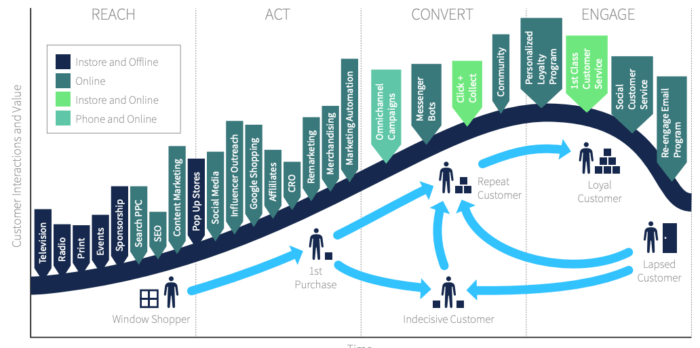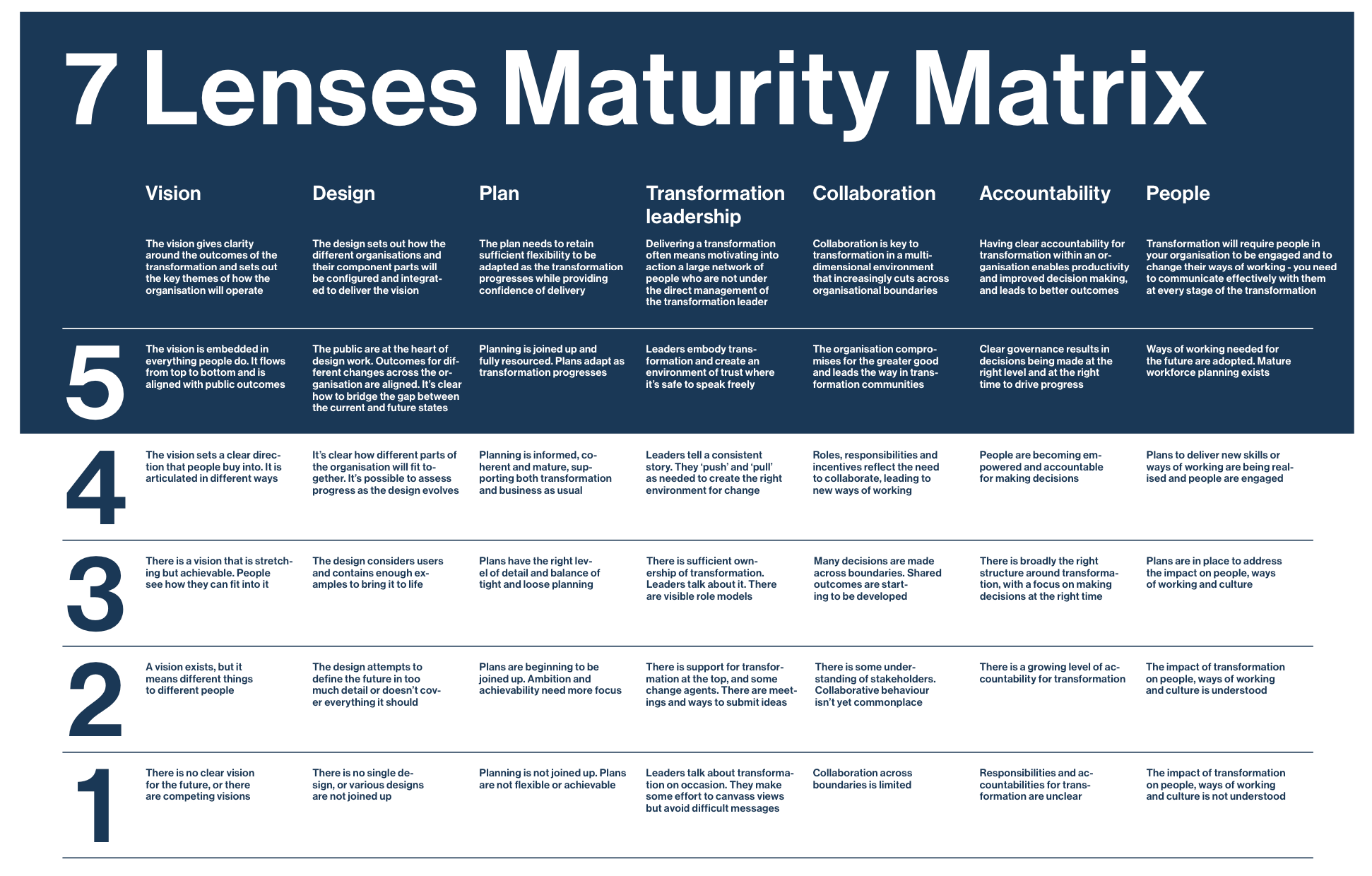Three essential steps to kickstart Digital Transformation
Digital Transformation is a focus for many organizations right now and as you can see from the Google Trends search volumes, it's increasing in popularity recently. As with any change within an organization, there are many challenges, so once you've identified digital advocates in the organization, it's time to map out the journey.
In recent months, several companies have mentioned to me that their CEO is committed to digital, but they're having challenges at middle management levels, where it's harder to gain commitment. This can be easier if there is a clear plan shared with all. You can, as many do, call this your digital roadmap, it describes where the business is now and where they're going.
There are several models available, for example, Dave Chaffey recommends the Carnegie Mellon Capability Maturity Model (CMM) in his post 'Using capability maturity models to review effectiveness and set targets for Digital Transformation'. Interestingly, he describes the early internet age which is less than twenty years ago, when many companies had claimed their domain name yet the website was 'under construction'. At that time many CEOs I was working with could not see why they needed a website when they had fantastic brochures, sales teams on the road, and great PR contacts!
Today, if a business doesn't have a good quality, branded website, you assume something is wrong. It's suspicious, not quaint. Your online presence is part of your authenticity, it is inconceivable to imagine a Fortune 500 or FTSE100 company without at least one website. In the same vein, in five years' time, we may consider companies without a digital strategy, or an integrated marketing strategy to be in the same time warp.
Step 1. Gain evidence before you get started with digital transformation
Before starting on a new journey, it's essential to gain some evidence. It's unlikely you'd plan a holiday without first checking weather reports, currency details, travel times, and hotel reviews. Yet in business, we frequently start on a project without evidence.
To ensure your digital transformation journey works, start with an audit to identify the 'where are you now?' question. This gives you benchmark information that can be used at a later stage. Within this I typically would review:
- What are your digital strengths and weaknesses? Use the TOWs matrix to make this more useful.
- What are your key competitors, or similar organizations doing?
- What's around the corner? This information is often not available online as it's often 'work in progress'. I recently attended the Academy of Marketing conference to explore what's new in marketing education, it was really useful and revealed the latest marketing thinking in research and education. Look at relevant events where you can meet other businesses in a similar situation.
Trying to work out where to get started? We recommend the 'digital strategy success factors' module in our Digital Transformation Learning Path to kick-start your planning. This strategic training module contains examples and templates designed to support you in building your digital transformation strategy. By the end of the module you'll be able to:
Find out more about this module plus our whole suite of digital transformation resources including planning templates, case studies, reports, and our popular Digital Transformation Playbook.
Core Module

Digital strategy success factors
Part of the Digital marketing strategy and planning Toolkit
Learn how to define a structure and scope for your omnichannel marketing strategy
Learn MoreYour customers' omnichannel experiences
When auditing your digital marketing strategy, don't forget to ask yourself, what do your customers want? Customers often find the path to the new product offer way before organizations do. Taking holidays as an example, consumers can spend hours, days and weeks to identify their ideal holiday (how long did it take you to plan your holiday this year?).
Yet, how many destinations, hotels, and attractions still produce masses of brochures? TripAdvisor conducts in-depth research each year and its latest report noted that
“When researching places to stay on TripAdvisor, 80 percent of respondents read at least six to 12 reviews before making their decision, and they’re most interested in recent reviews that will give them the freshest feedback.
More than half of respondents (53%) will not book a hotel that does not have reviews.”
Yet at the same time, many hotels and restaurants ignore the reviews and worst still, some argue with the customer! If you're in the hospitality sector, and if you ignore reviews online and your bookings are down, there is a reason. Is it time to ditch the brochures and focus on the reviews?
Keeping track of a constantly evolving marketing strategy can be tough if you're not tracking your omnichannel marketing channels and platforms in a consistent way. That's why digital transformation is so important for businesses of all shapes and sizes to manage their customers' experiences of their companies.
Our RACE Framework helps digital transformation leaders plan, manage, and optimize their marketing strategies across the customer lifecycle of reach, act, convert, and engage.

Step 2. Create clear objectives about where the business is going
Once the audit stage is completed, it's useful to understand what does your organization want to achieve? Are there specific objectives? Is there a future milestone that's driving practice within the business? Or has your business started to notice that it's being left behind?
To move to the next step, use a model or roadmap. I'd recommend the 5S marketing goals as a tool to develop business objectives. This is because many objectives focus on the numbers, which is essential, but it leaves out other factors. The 5Ss which was originally designed as a website review tool (and still works for this purpose) is an easy-to-use ‘objective generator’. It’s worth working on the objectives with a team so you get some early buy-in.
Looking to take the next step to digital transformation? Our dedicated marketing strategy solutions support Business Professional Members and their teams manage the key aspects of digital transformation for their businesses.
For example, our 'setting the vision for digital transformation' advanced module in our Digital Transformation Learning Path provides strategic marketing training and tools needed to create a vision statement for digital transformation in your business, explaining the benefits of digital transformation to your colleagues or clients and persuading them why investment and change is needed.
Advanced Module

Set vision for digital transformation
Part of the Managing digital marketing transformation Toolkit
Learn how to explain the future opportunities of digital marketing to your colleagues or your clients in a compelling way
Learn MoreExamples of transformation timescales
Even so, it's important to understand that the process doesn't happen overnight, it can take some time. Dell is a good example of a company that's constantly adapted to customer and market needs, from 1996 when Dell.com launched, generating $1 million in sales per day just six months after the site went live, to 1999 when they blazed a trail and took technical support online, when others said it couldn’t be done. Dell shares its story and we’ve included it previously as a great example of how a company has managed its transformation.
In an article from Cap Gemini, they highlighted Starbucks who adapted their business to embrace digital, after a series of disappointing results. From free WiFi to adding mobile payments, they have created a difference in today’s ever-crowded coffee shop market.
The New York Times is probably the best-known news publisher in the USA. Founded in 1851 it’s recently embarked on a program of digital transformation, forced due to a changing macro environment and competitors who have moved ahead. And with the advent of new, younger competitors, like the Huffington Post who started less than ten years ago, and have eclipsed the readership of the NYT.
In the past the idea of a start-up gaining more web visitors than the best known political paper was unthinkable. Yet the Huffington Post has a higher web rank both in the US and globally.
What’s needed for digital transformation to work?
The UK government and indeed the US government is embarking on programs of digital transformation. This seems to be driven by customer need (I want to pay bills online, so send me an email with a link) and cost-saving, reducing the amount of paper issued, documents printed and postage every year.
The UK government’s vision is ‘Digital by Default’. I've used this transformation dashboard on several training courses as it sums up the vision succinctly. There is a supporting paragraph for anyone needing more detail and one of the reasons it will work is that they’ve started to classify where each department is on its roadmap.

As would be expected within major institutions such as government services, the steps to digital transformation start with discovery, what are the users’ needs, and will it work? Stage two is alpha where the objective is to build a working prototype to be used by stakeholders to gain a greater understanding of a service.
What’s interesting is that this stage is time-bound to take no more than eight weeks. I wonder if that always happens? Stage three is beta, where the service is tested and improved until it reaches stage four, live.
Our 'define digital value proposition' module, in the Digital Transformation Learning Path, is packed with strategic marketing tools and templates for Business Professional Members to review the strength of their digital value proposition and benchmark digital value propositions and brand propositions.
Core Module

Define Digital Value Proposition
Part of the Digital marketing strategy and planning Toolkit
Learn how to craft a powerful Digital Value Proposition (DVP) and how this differs from a brand proposition
Learn MoreDigital transformation roadmap
In the USA, President Obama launched his digital strategy with the question “I want us to ask ourselves every day, how are we using technology to make a real difference in people’s lives?” This evolved into their vision “Information and services anywhere, anytime, on any device".
Unfortunately, this transformation dashboard is no longer published, but in 2019, the Government digital service shared this useful 7 Lenses Maturity matrix which we recommend for reviewing the capacity of a business to transform and to identify what the barriers are. It combines both vision and implementation, as a sort of roadmap.

Step 3. Defining the process to launch the digital transformation strategy
In all these examples, there are three common factors which you need to adopt to get started with your digital transformation. This is the first step in your digital roadmap.
- A high-level advocate
- A clear vision
- A digital team
A high-level advocate
You need support from the highest level to transform your business and adopt digital tools, techniques, and technology. If you don’t get buy-in from the C-suite, it’s difficult to achieve. Identify your champion or advocate early and ensure they're in a position to get things done.
A clear vision
In the past companies had ‘mission statements' that were so long, they were printed onto the back of business cards as an aide-memoire! Today your vision has to be clear, memorable, and succinct.
A digital team
Teams are formed to transfer knowledge, provide support and enable existing staff and departments to adopt digital. Teams may be formed as a working party within your organization and supplemented with digital training.












